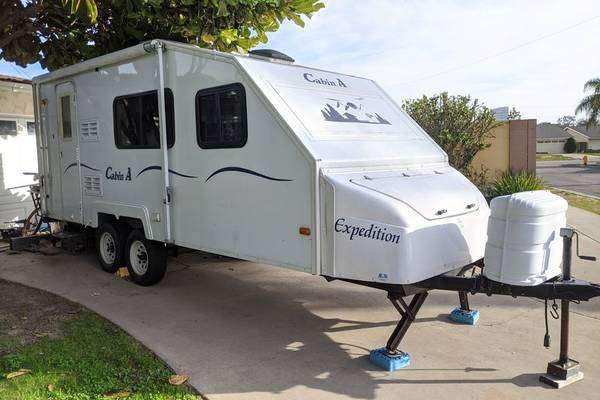
Aliner vs Cabin A Expedition Travel Trailer (Weight)
When you go light with your trailer, it means that you can use an economical car to do the towing. That is a gas-saving you won’t be able to enjoy with larger tow vehicles. Light may mean small but then you may not need a large trailer to camp in.
For the cabin A model you are looking at starting around 1300 pounds approx. while the Aliner can range from 1100 on up. The weight of each trailer will be determined by the year it was made, the features inside, and the construction materials used. As well as the length of the trailer.
To learn more about the difference in weight, just continue to read our article. It explores the topic so you can have a great idea of what type of car you need to tow these two trailers. Take a few minutes to see if they are light enough for your vehicle.
Cabin A Expedition Travel Trailer

The two trailers seem to be made by the same company, Columbia Northwest. The Cabin A is the earlier model and was built in the early 2000s. The 2006 model was not foldable which gave the owner much more storage room.
Plus, the design of the trailer did not exclude most standard features. You got the usual fridge, stove, wet bath as well as a side-mounted AC unit. On top of those items, you also had a good water heater, a full-size bed, and a dinette.
Its lightweight meant that you could tow it with almost any vehicle you owned but double-check as the weight of any passengers and supplies will lower your towing ability.
Then the aerodynamic design helped you get a little fuel economy and stretch your camping dollars a little further. The interior was basic and a little compact for some people but you may have been able to buy this in longer lengths.
If so, your weight would go up and maybe exclude certain vehicles from towing it.
2004-2006 Aliner Expedition Specifications

The 2004 model could only sleep 2 people and came with an exterior width and height measuring the same distance- 6 feet 7 inches each way. The bed was 78 by 54 inches and the overall length was 15 feet.
the dry weight was approx. 1400 pounds and the trailer could be set up in about 5 minutes. This was a foldable model with a hardtop. Many of these older models have been renovated and upgraded by different owners over the years so the inside features may change.
The 2006 was upgraded over the 2004 and came weighing GVWR 2000 pounds with about 1000 pounds leftover for cargo and passenger weight. The main bed was 76 by 54 inches and had an extra bed that measured 76 by 42 inches.
The features you got depended on the model of trailer you bought. The smaller Scout did not come with much more than a bed, a propane tank, and a 15-gallon freshwater tank. It uses 3 different power sources, q20 AC, 12 volt DC and propane.
It too could be towed by most vehicles and it too should be set up very easily.
Aliner Expedition Weight

This category will also depend on the model you buy. The figures given here are only for one specific trailer and your trailer may be a bit different. The dry weight came in roughly at 1300 pounds and the tongue weight is 150 pounds.
With the tongue, the trailer measured 18 feet in length and without it, you had approx. 15 feet of living space. 4 leveling jacks made sure you could keep the trailer flat and even for a good night’s sleep.
What added to the weight of this trailer was the 3-way fridge, 3 burner stove, water heater, and microwave. The design of the trailer was great for towing. You had less wind resistance due to the sloping front. One propane tank sat on the tongue and there were storage cabinets above and below the features.
All of this means that the weight was kept to a minimum so that you could use whatever vehicle you are comfortable with driving could be used. Maneuvering should be a piece of cake as well as you do not have to worry about backing up a large and long trailer.
Aliner vs Cabin-A

Both of these trailer models are said to be made by the same company. In fact, some ads use both names in their headings when talking about these trailer options.
The Cabin-A may be the first model produced by Columbia Northwest and the Aliner may have been the upgraded version. They are both small, rarely going over 20 feet in length without the tongue.
Despite occupying the first 2 spots on at least one top 10 list the Aliner does come with its share of problems. One main issue is that it doesn't always seal properly. gaps between the roof and sides have been found by some owners.
Another issue is that the Aliner is not cheap. While you can pick up a used Cabin A trailer for under $10,000 the newer Aliners can run you close to $30,000. The expense doesn't spare you any maintenance work either.
These trailers seem to need more maintenance work to stay in top shape. If you are tall, the beds may be a bit short for you but this is a problem with almost all small and lightweight trailers.
Some Final Words
Make sure to do your own comparison as that is the best way to find the trailer that fits your lifestyle best. There are a lot of these trailer models and some come with different floor plans. They are lightweight but they are small so make sure you can live with very little living space.

